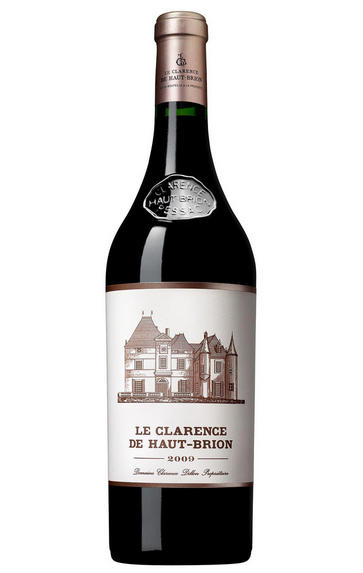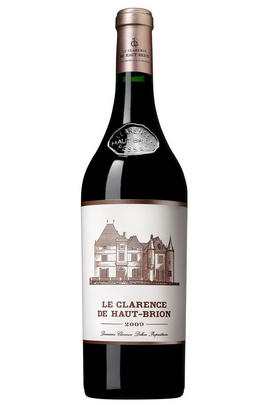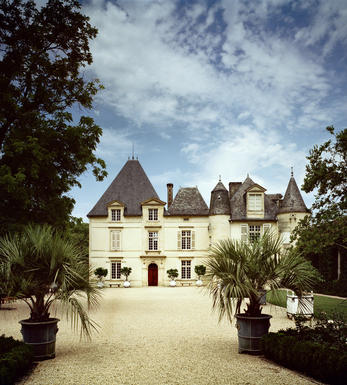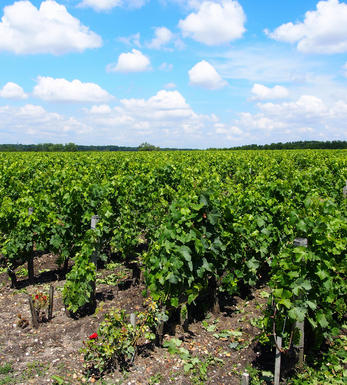
2020 Le Clarence de Haut-Brion, Pessac-Léognan, Bordeaux

Critics reviews
The 2020 Le Clarence de Haut-Brion has a succulent bouquet of dark cherries, boysenberry and crushed violet scents, quite heady and bold for a second wine (even the second wine of a First Growth!). The palate is medium-bodied with succulent, pliant tannins that frame the pure black cherry, wild strawberry and black currant fruit. Veins of licorice appear toward the finish. There is a lot of density in this Le Clarence and a little more structure than usual, and it suits it well.
Drink 2024 - 2040
Neal Martin, Vinous.com (May 2021)
The 2020 Le Clarence de Haut-Brion is a jewel of a wine. Deep, powerful and structured, it captures all of the gravitas of the Grand Vin, but in a more accessible style. Gravel, leather, tobacco, cedar and dried herbs lend quite a bit of aromatic nuance to this powerhouse Pessac-Léognan. I very much like the intensity and drive here.
Drink 2025 - 2035
Antonio Galloni, Vinous.com (June 2021)
Concentrated, with impact and punch. It has presence and barely takes a beat through the mid palate, as there is such a wall of blackberry and bilberry fruits. A brambly hedgerow feel, hard to argue with - but be aware that there is heat also; and this is a hedonistic wine. Harvest from 7th to 29th September.
Drink 2028 - 2036
Jane Anson, Decanter.com (April 2021)
A blend of 60.1% Merlot, 31.7% Cabernet Sauvignon, 6.7% Cabernet Franc and 1.5% Petit Verdot, harvested from the 7th to the 29th of September, the 2020 Le Clarence de Haut-Brion has an estimated alcohol of 15.2%.
Deep purple-black in color, it bursts from the glass with notions of baked black cherries, blackberry pie and plum preserves, leading to hints of ripe redcurrants, spice cake and smoked meats, plus a touch of hoisin.
The big, rich, full-bodied palate is a full-on decadent mouthful, featuring lovely freshness to lift all that rich black fruit and a velvety texture, finishing long and spicy. A beautiful behemoth that is going to wow the hedonists
Drink 2024 - 2040
Lisa Perrotti-Brown MW, Wine Advocate (May 2021)
Cask sample taken 12 April. 60.1% Merlot, 31.7% Cabernet Sauvignon, 6.7% Cabernet Franc, 1.5% Petit Verdot. Estimated alcohol: 15.2%. Picked from 7 to 29 September. Mid purplish crimson. Rather simple, or at least uncommunicative, on the nose at present, though there is a beguiling combination of ripe fruit and stoniness (warm bricks?) on the palate which has impressive concentration.
Comparing it with other celebrated Pessac-Léognans of the same vintage, it is clear that this has some magic dust – as it should considering how much more expensive it is. Lots of leathery tannin underneath but it is the integrity of the fruit that is so impressive.
Drink 2029 - 2048
Jancis Robinson MW, JancisRobinson.com (April 2021)
Exotic fruit aromas of blackberry, blueberry, peach and orange peel. It’s full-bodied with a vertical flow of layered, chewy tannins that are integrated and intense. Extremely polished and focused. Crushed stone to the fruit in the aftertaste. Some bark and forest flowers, too. Great potential.
James Suckling, JamesSuckling.com (April 2021)
Leading off the reds, the 2020 Le Clarence De Haut-Brion is a darker, more structured version of this cuvée that has lots of ripe blackcurrant fruit, notes of scorched earth, tobacco, cedar, and lead pencil, medium to full body, ripe tannins, and a great finish. With its brilliant Graves character, this is a second wine that deserves 4-5 years of bottle age and will evolve for two decades.
Drink 2027 - 2047
Jeb Dunnuck, JebDunnuck.com (March 2023)
Ripe blackberry Merlot to smell; full, moderately concentrated, firmly but finely tannic; a refined and relatively delicate core of fruit here, sweet and fresh, with the alcohol presence distracting a bit from its finesse, but behind that, this is long and graceful, with excellent sweet fruit persistence.
The somewhat “dryhard” tannin texture distracts a bit, which it would not do at 13.5% ABV, for example. A refined, freshly sweet, graceful wine, successful in the style, if not so obviously Pessac-Léognan in origin any more.
Drink 2028 - 2038
Michael Schuster, The World of Fine Wine (May 2021)
About this WINE

Chateau Haut-Brion
The only property from outside the Médoc to be included in the 1855 Classification, Haut-Brion’s viticultural history can be traced back further than its Médoc First Growth counterparts. Samuel Pepys even mentions it in his diaries. Situated in what is now Pessac-Léognan, the property finds itself now in the suburbs of the ever-encroaching city of Bordeaux.
After falling into a state of disrepair the estate was purchased in 1935 by Clarence Dillon, an American financier, since when it has enjoyed a steady and continual resurgence to a position of pre-eminence. Dillon’s great-grandson, Prince Robert of Luxembourg, now runs the estate, but a key influence in the reputation which Haut-Brion enjoys today is the Delmas family. George Delmas was manager and wine-maker until 1960, when his son Jean-Bernard took over. Jean- Bernard was a visionary figure, responsible for a number of important innovations, and on his retirement in 2003 his son Jean-Philippe took over as Directeur Générale.
The vineyard is planted to 40% Cabernet Sauvignon, 37% Merlot and 18% Cabernet Franc. A stunning white wine is also made, from a part of the vineyard which is 63% Semillon and 37% Sauvignon Blanc. Production is smaller than at the other First Growth Wines, totalling about 20,000 cases, shared between the Grand Vin and a second wine, formerly called Bahans-Haut-Brion but changed in 2007 to Clarence de Haut-Brion in recognition of Clarence Dillon. Production of Haut Brion Blanc is minute, less than 800 cases in most years.
Beginning with the 2009 vintage a new white wine was introduced in the place of Clarence: La Clarté de Haut-Brion, the offspring of Domaine Clarence Dillon's two prestigious white wines: Château Haut-Brion Blanc and Château La Mission Haut-Brion Blanc.
Fermentation of the red wines takes place in stainless steel vats, after which the wine will spend 22 months, sometimes more, in new oak barrels before being bottled unfiltered. For the white wine fermentation takes place in new oak barrels, after which the wine spends a further year to 15 months on its lees in barrel before bottling. The white wine is truly sensational, equivalent in class to a top-flight White Burgundy Grand Cru, but its scarcity means that it is rarely seen.
The red wine is no less extraordinary; at its best it displays text-book Graves characteristics of cigar-box, curranty fruit, earth, smoky spice and cassis. The high Merlot content, compared to the Médoc First Growths, gives it a voluptuous edge, but does not in any way detract from its ability to age.

Pessac-Leognan
In 1986 a new communal district was created within Graves, in Bordeaux, based on the districts of Pessac and Léognan, the first of which lies within the suburbs of the city. Essentially this came about through pressure from Pessac-Léognan vignerons, who wished to disassociate themselves from growers with predominately sandy soils further south in Graves.
Pessac-Léognan has the best soils of the region, very similar to those of the Médoc, although the depth of gravel is more variable, and contains all the classed growths of the region. Some of its great names, including Ch. Haut-Brion, even sit serenely and resolutely in Bordeaux's southern urban sprawl.
The climate is milder than to the north of the city and the harvest can occur up to two weeks earlier. This gives the best wines a heady, rich and almost savoury character, laced with notes of tobacco, spice and leather. Further south, the soil is sandier with more clay, and the wines are lighter, fruity and suitable for earlier drinking.
Recommended Châteaux: Ch. Haut-Brion, Ch. la Mission Haut-Brion, Ch. Pape Clément, Ch Haut-Bailly, Domaine de Chevalier, Ch. Larrivet-Haut-Brion, Ch. Carmes Haut-Brion, Ch. La Garde, Villa Bel-Air.

Cabernet Sauvignon Blend
Cabernet Sauvignon lends itself particularly well in blends with Merlot. This is actually the archetypal Bordeaux blend, though in different proportions in the sub-regions and sometimes topped up with Cabernet Franc, Malbec, and Petit Verdot.
In the Médoc and Graves the percentage of Cabernet Sauvignon in the blend can range from 95% (Mouton-Rothschild) to as low as 40%. It is particularly suited to the dry, warm, free- draining, gravel-rich soils and is responsible for the redolent cassis characteristics as well as the depth of colour, tannic structure and pronounced acidity of Médoc wines. However 100% Cabernet Sauvignon wines can be slightly hollow-tasting in the middle palate and Merlot with its generous, fleshy fruit flavours acts as a perfect foil by filling in this cavity.
In St-Emilion and Pomerol, the blends are Merlot dominated as Cabernet Sauvignon can struggle to ripen there - when it is included, it adds structure and body to the wine. Sassicaia is the most famous Bordeaux blend in Italy and has spawned many imitations, whereby the blend is now firmly established in the New World and particularly in California and Australia.


Buying options
Add to wishlist
Description
The 2020 Le Clarence de Haut-Brion has a succulent bouquet of dark cherries, boysenberry and crushed violet scents, quite heady and bold for a second wine (even the second wine of a First Growth!). The palate is medium-bodied with succulent, pliant tannins that frame the pure black cherry, wild strawberry and black currant fruit. Veins of licorice appear toward the finish. There is a lot of density in this Le Clarence and a little more structure than usual, and it suits it well.
Drink 2024 - 2040
Neal Martin, Vinous.com (May 2021)
wine at a glance
Delivery and quality guarantee